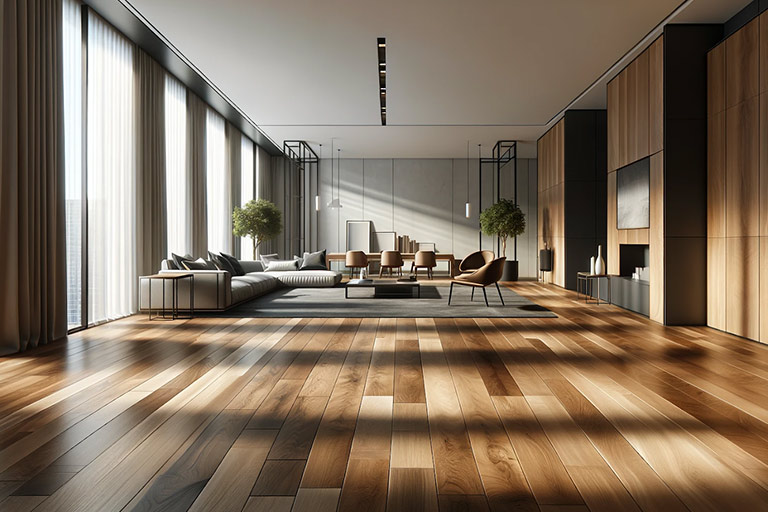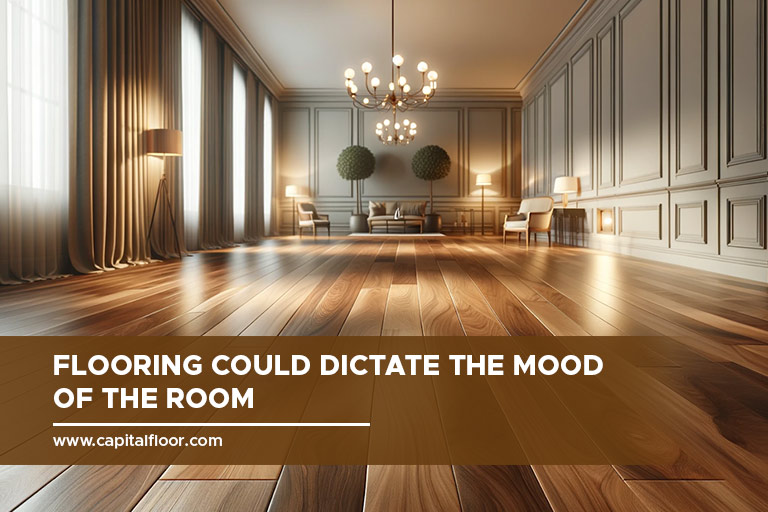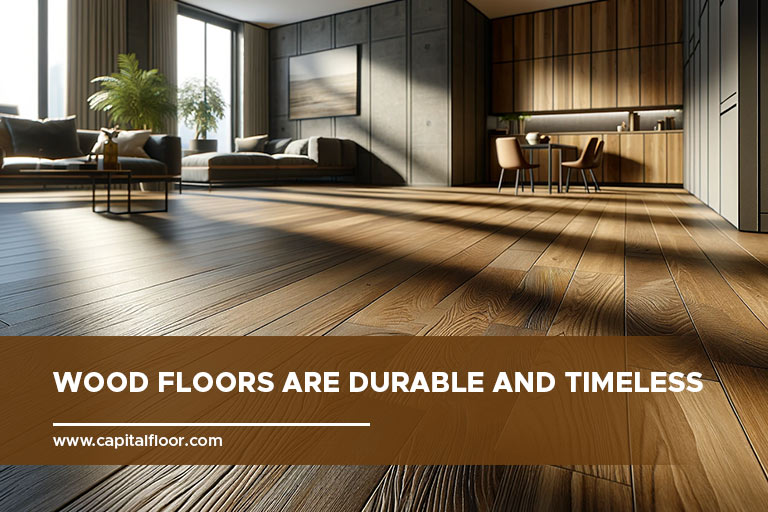Our showroom is open to the public. Please click HERE for more details.
Our showroom is open to the public. Please click HERE for more details.

Wood flooring has long been a cornerstone in the realm of interior design, offering a blend of aesthetic appeal and practical functionality that few other materials can match. Its versatility allows it to fit seamlessly into various design themes, from rustic charm to modern minimalism. They bring warmth, character, and a natural essence to any room. Their timeless elegance and enduring quality make them a popular choice for homeowners and designers alike.
Let’s explore the vital role of wood flooring in interior design, examining its impact on both the visual and practical aspects of living spaces.
Floors are a crucial element in interior design, influencing not only the visual aesthetic but also the tactile experience of a room. They can alter the perception of a room’s size, shape, and overall ambience, making them a central consideration for designers and homeowners.
The types of flooring in interior design play a crucial role in determining the overall character of a space. Hardwood floors offer an ageless, organic appeal, suitable for both classic and contemporary spaces. Tiles have versatility in design and colour, suitable for a modern, clean-lined look. Carpets provide luxury and comfort, softening the room’s appearance. Each flooring type sets the tone and style of a space, influencing furniture, decor, and wall colour. Each unique characteristics can influence the overall aesthetic character.
Flooring plays a crucial role in creating visual flow within and between spaces, guiding the eye and movement through the home. Consistent flooring enhances unity and spaciousness in open-plan layouts, while different choices can delineate areas without physical barriers. Floorboards, tile patterns, and rug placement can strategically direct attention, creating focal points and continuity between rooms. Thoughtfully selected flooring unifies disparate elements, creating a cohesive interior design scheme.
Flooring is a crucial aspect of interior design, influencing its durability, maintenance, and suitability to lifestyle and environmental conditions. Resilient materials like hardwood or porcelain tiles are preferred for high-traffic areas, while softer options like carpets are suitable for low-traffic, intimate spaces. Scratch-resistant surfaces are essential for families with children or pets. The choice of flooring also impacts indoor climate control, with tiles keeping spaces cool in warmer climates and carpets providing insulation in colder ones.

The material and colour of the floor can evoke different feelings, setting the tone of the room. For example, light-toned tiles in bathrooms create a refreshing atmosphere, while rich hardwoods in living rooms and libraries instil warmth and coziness. Soft, plush carpets in relaxation or meditation spaces create a serene and comfortable environment. The choice of flooring is crucial in establishing the desired emotional and sensory experience in a room.
Wood flooring is a popular choice in modern interior design due to its versatility, durability, and natural beauty. It complements various design styles, from minimalist to rustic, making it a central feature in today’s interior design landscape. Here are some reasons behind wood flooring’s enduring popularity and its role in shaping modern living spaces.
Wood flooring is not a modern invention. Its roots trace back centuries, showcasing its enduring appeal. Historically, wood floors were a symbol of opulence and were commonly found in castles and estates. Over time, advancements in technology and accessibility have made wood floors a more feasible option for a wider range of homes. The latest wood floor designs seamlessly integrate modern aesthetics with the timeless beauty of wood, offering a contemporary twist to this age-old tradition. This historical context adds a layer of richness and depth to the wood flooring, making it a timeless addition to any interior.
With a variety of wood types, stains, and finishes available, wood floors can complement any interior design scheme. Lighter woods like maple or birch can create a more airy, open feel in a space, while darker woods like walnut or mahogany offer a sense of grounded sophistication. The grain patterns and natural imperfections of wood add unique character to each plank, ensuring no two floors are exactly alike.
In an era where environmental responsibility is paramount, incorporating wood in interior design is a sustainable choice. Many wood floors are made from renewable resources, and the longevity of hardwood floors means less frequent replacement and reduced waste. Additionally, wood is a natural insulator, helping to regulate indoor temperature and reduce energy costs. For those seeking eco-friendly options, reclaimed wood flooring offers a rustic charm and reduces the demand for new timber.
Wood floors offer significant health benefits, especially for those suffering from allergies. Unlike carpets, wood floors don’t harbour allergens, dust, or pet dander, making them a cleaner, healthier choice for indoor environments. The ease of cleaning and maintenance of wood floors further contributes to a healthier living space, reducing the presence of irritants that can affect air quality.

The durability of wood flooring is unmatched. When properly maintained, wood floors can last for decades, even centuries. Their ability to withstand daily wear and tear makes them an excellent long-term investment for any home. Additionally, wood floors can be refinished, allowing homeowners to rejuvenate their floors without the need for a complete replacement, adding to their sustainability and cost-effectiveness.
Wood flooring is an investment in your property. Homes with wood floors often see an increase in market value, making them a desirable feature for homebuyers. The timeless appeal and durability of wood flooring make it a smart choice for those looking to enhance their home’s value.
In modern interior design, the choice of flooring is integral to establishing the overall aesthetic, and understanding interior design rules for flooring is paramount. Whether aiming for a minimalist, contemporary, or traditional look, wood flooring provides the versatility to achieve the desired aesthetic. Its natural beauty and warmth add depth and texture to modern interiors, creating a harmonious balance between nature and contemporary design.
Wood flooring remains a key element in interior design, offering unmatched aesthetic versatility, durability, and a host of practical benefits. Whether you are renovating an old home or designing a new one, consider the transformative power of wood flooring.
For those seeking quality hardwood flooring in Toronto, look no further than Capital Hardwood Flooring. Call us at (416) 536-2200 to start your home’s transformation today.